 Winter availability
Winter availability
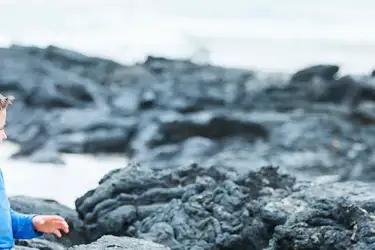
Which animals can you see when visiting the Galapagos Islands?
Published 21 June 2023
One highlight of a charter to the Galapagos Islands is the chance to see all the different native animals. Discover and learn more with the Burgess guide.
The Galapagos, a volcanic archipelago in the Pacific Ocean, has held a mystical allure to those with a love of nature since Charles Darwin first set foot on its terroir in 1835. The variety of animals found in the remote Galapagos Islands is unlike anywhere else on Earth, with endemic species unique to the area, the most famous of which is the giant Galapagos tortoise. But animals both large and small provide a rare insight into life on the 18 islands, with penguins, iguanas, turtles and a vast array of sea birds putting on daily displays for the lucky few who visit.
Wildlife observation on the Galapagos Islands
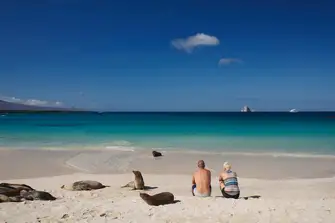
Located approximately 1,000km off continental South America, it is the region’s isolation that has led to the unique variety of wildlife species that inhabit the islands and make up the Galapagos Islands' delicate ecosystem. It has taken millions of years to develop and evolve, and it’s vital that visitors respect the natural order, which is why there are important rules and regulations laid out by the Galapagos National Park for visitors. These include keeping to the marked trails and maintaining a safe distance from the wildlife. The sea lions are super friendly, but feeding and petting animals is understandably prohibited, as is smoking and littering. In fact, visitors must refrain from taking any form of food onto the islands and to wear clean shoes to prevent contamination. The best tip of all, it to listen to your guide and always follow their instructions. The rest is plain sailing.
Galapagos Giant Tortoise
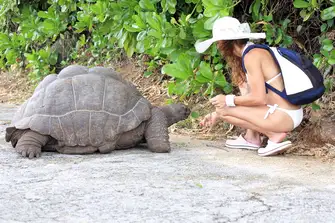
The famous Galapagos Giant Tortoise lives up to its name. Weighing up to 417kg, it is the largest living tortoise on the planet. Despite averaging more than a hundred years in age and comprising 15 sub species, only around 15,000 remain in the wild today. The archipelago is named after the Galapagos Giant Tortoise (The Spanish word for tortoise is galapago) and it remains a must-see sight when visiting the islands.
Blue Footed Booby
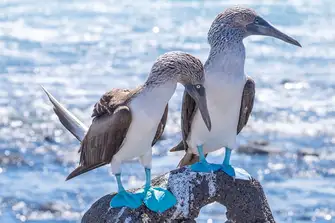
The Blue Footed Booby, a wide-eyed marine bird native to subtropical and tropical regions, is easily identified from afar by its beautiful bright turquoise webbed feet and legs. Even the eggs that the female lays are light blue in colour. The Galapagos Islands' population includes around half of all breeding pairs of Blue Footed Boobies in the world. The Galapagos hawk is the booby’s only natural predator on the islands, and as a result it’s known for being tame and docile around humans.
Marine Iguana
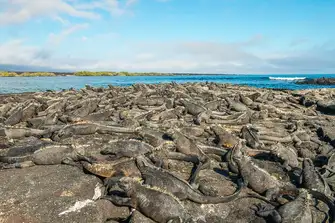
The Galapagos Marine Iguana is only found on the Galapagos Islands and it’s a reptile of many talents. They feed off algae on the rocks, and are the only lizards known to forage for food in the oceans. In fact, they have a specially adapted gland that removes salt from their bodies. They have also evolved to master the ability to shrink in size, becoming as much as 20 percent shorter, in response to irregularly occurring climate cycle that influences temperatures and precipitation around the world. This adaptation increases their chances of survival during warm phases when up to 90 percent of their populations could perish.
Galapagos Sea Lion
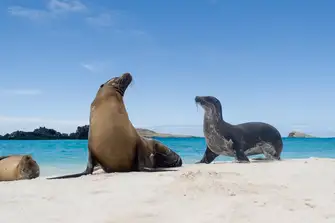
Super friendly and often spotted basking salubriously on rocks in the sun, the Galapagos Sea Lion is the smallest of its species and the animal most spotted by visitors. It’s always important to keep a respectful distance and not approach them, but when in the water the possibility to swim with these majestic and hugely playful creatures is often up for grabs, especially with the pups, which can be identified by their nearly flat heads and tend to stay in the shallows until at least five months old.
Sally Lightfoot Crab
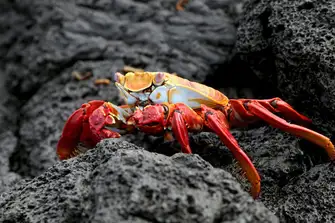
Not all worthwhile sightings are large. The land-dwelling Sally Lightfoot Crab is vibrant in colour when mature, with a flaming red and yellow carapace that contrasts with the lava rocks beaches. It has developed various adaptations to help with survival, such as powerful claws that serve as spoons when feeding and can rip apart the flesh of dead organisms. More notably, they carry water inside their carapace to compensate for the excessive amount of time spent on land, periodically pouring it over their gills to keep breathing. It also serves as a defence mechanism; when threatened, the crab projects water towards its attacker in the hopes of scaring it away.
Galapagos Penguin
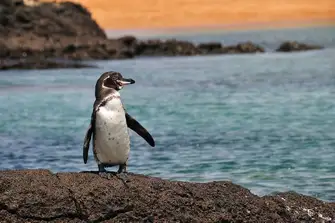
The Galapagos Penguin is the only penguin found north of the equator. The tropical latitude would be unviable for the aquatic bird, if it weren’t for the cool waters of the Humboldt and Cromwell Currents. These waters also play home to cold-water schooling fish, such as anchovies, sardines and mullet, all of which form the Galapagos Penguin’s stable diet. They also dine on small crustaceans, invertebrates and fish, diving up to 50m at a time to catch them.
Green Sea Turtle
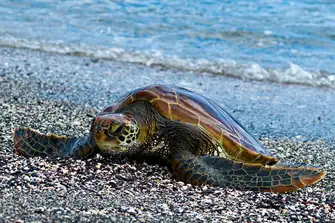
The Green Sea Turtle is the largest hard-shelled sea turtle in the world, and the only sea turtle that is an herbivore. Its diet of seagrass and algae gives its body fat a green hue, from which its name derives. The Green Sea Turtle lives in many waters, though is classified as endangered due to the overharvesting of its eggs, being caught in fishing gear and the loss of nesting beach sites. Unlike other turtles, they cannot retract into their shell, but they can hold their breath for up to five hours underwater.
Darwin's Finches
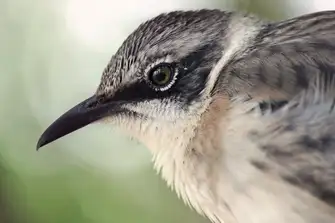
It was the beaks on Darwin’s namesake Finches that first captured the naturalist’s attention. He noticed that the bird’s had developed different sized beaks to suit a variety of food types, from large seeds to invertebrates, and even bird blood – all diets that would be inedible to other finches. He noted that long, pointed beaks served well for snatching insects while broad, blunt beaks work best for cracking seeds and nuts. It was a defining discovery that formed the basis of his theory of evolution.
Galapagos Land Iguana
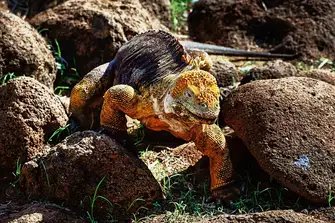
Found in the dry lowlands of the islands of Fernandina, Isabela, Santa Cruz, North Seymour, Baltra and South Plaza, the Galapagos Land Iguana is a large species of lizard endemic to the Galapagos Islands. They are recognised as being more colourful than their marine cousins, sporting an iridescent golden yellow skin. As cold-blooded reptiles, they are often found relaxing on rocks, soaking up the heat of the sun.
Magnificent Frigatebird
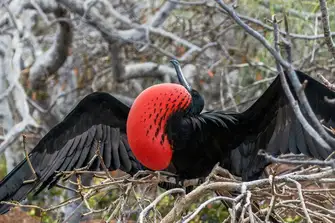
The Magnificent Frigatebird, also known as the ‘man-o-war bird’ is a tyrant of the skies. Rather than foraging for its own food, it harasses other birds until they regurgitate recently captured food, which the Frigatebird then snatches in mid-air. Its aptly named after the maritime term frigate, a fast warship, though its behaviour is less about attack and more about survival. Unlike other seabirds, the Magnificent Frigatebird’s wings are not water-resistant. They’re particularly exciting to see during mating season, when the males sport a striking red gular sac, which they inflate to attract a female.
Speak to a Burgess charter broker to discover more about charter opportunities to the Galapagos Islands
Our knowledgeable team of Burgess charter brokers are well positioned to support and advise on the most suitable superyacht to charter in the Galapagos Islands. Contact us today to learn more about visiting the golden sandy shores of this tranquil top yachting destination.
To find out more about Burgess’ yachts for sale and yachts for charter, please contact a Burgess broker. Alternatively, get in touch with one of our offices directly: London, Monaco, New York, Miami, Singapore or all other locations.
 Burgess 50: Our top five social posts in 2025
Burgess 50: Our top five social posts in 2025
 Catamaran GOOD DAY SUNSHINE sold
Catamaran GOOD DAY SUNSHINE sold

